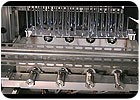Harland Medical Systems (Eden Prairie, MN) builds machines that are used by medical device manufacturers to apply coatings to products like catheters.

Medical coating machine builder Harland Medical Systems uses a set of four spray valves to apply a UV-cure coating to urinary catheters without clogging the two small openings at their tips.
“We can essentially provide device makers with the performance of a custom coating system, but without the high cost or long lead time, which can be a huge advantage when building products with short life cycles, or introducing a new product when time-to-market is critical,” says Harland vice president of marketing, Drew Summerville.
Harland recently built a custom coating machine for a manufacturer of urinary catheters, which proved especially challenging because of the small size of the components involved. Specifically, the UV-cure coating had a tendency to bridge over the two openings at the tip of each catheter. To solve the problem, Harland engineers needed to find an alternative to the dip-coating process traditionally used in high-volume catheter manufacturing.
“With dipping, the sheer volume of fluid can plug small openings, especially on devices with complex geometries,” Summerville says.
Ultimately, Harland implemented a set of 781-Series spray valves from dispensing equipment manufacturer EFD Inc. (East Providence, RI). The 781 Series features low-volume, low-pressure operation, which uses extremely low nozzle pressure to apply a fine, even coating with very little overspray.
In operation, the coating machine uses an overhead conveyor to automatically position a pallet of 48 catheters above four valves fixtured on both sides of a rectangular coating station. The catheters rotate during spraying to ensure a uniform coating thickness.
Harland’s new system allows the customer to clean, coat and cure a batch of 48 catheters every 3 minutes. The EFD valves have virtually eliminated the possibility of the UV material webbing or bridging over the small openings. Another advantage of the new system is that the coating material is supplied to the valves via a closed tank, which simplifies changeovers and eliminates the downtime and waste involved with emptying static dip tubes.
“The EFD valves have proven extremely effective for this application,” Summerville says. “They produce a coating as good or better than dipping, but without the risk of blocking the openings or getting material inside the catheter.”
For more on dispensing and spraying, call 800-556-3484 or visitwww.efd-inc.com.
For more on medical device assembly and coating, call 952-941-0475 or visitwww.harlandmedical.com.